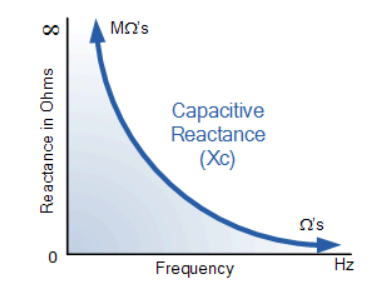When a DC voltage is applied to a capacitor, the capacitor itself draws charging current from the power supply and charges it to a value equal to the applied voltage
Similarly, when the power supply voltage decreases, the charge stored in the capacitor also decreases and the capacitor discharges. However, in an AC circuit, the applied voltage signal continuously changes from positive to negative at a rate determined by the power supply frequency, such as in the case of a sine wave voltage, where the capacitor is continuously charging or discharging at a rate determined by the power supply frequency.
When a capacitor is charged or discharged, the current flows through the capacitor and is limited by the internal impedance of the capacitor. This internal impedance is commonly referred to as capacitive reactance and is represented by the ohmic symbol XC.
Unlike resistors with fixed values, such as 100 Ω, 1k Ω, 10k Ω, etc. (this is because resistors comply with Ohm's law), the capacitance reactance varies with the applied frequency, so any change in power frequency will have a significant impact on the capacitance value of the capacitor.
As the frequency applied to the capacitor increases, the effect is to reduce its reactance (measured in ohms). Similarly, when the frequency at both ends of the capacitor decreases, its reactance value also increases. This change is called the complex impedance of a capacitor.
The existence of complex impedance is due to the fact that electrons in the form of charges on the capacitor board appear to transfer from one board to another faster than the changing frequency.
As the frequency increases, the capacitor transfers more charge on the board within a given time, resulting in greater current flowing through the capacitor, just as the internal impedance of the capacitor decreases. Therefore, capacitors connected to circuits that vary within a given frequency range can be said to be frequency dependent.
Capacitive reactance has the electrical symbol XC, which is measured in ohms and is the same as resistance (R). It is calculated using the following formula: capacitive reactance

Among them,
Xc=capacitance reactance in ohms (Ω)
π=3.142
ƒ=Frequency in Hertz (Hz)
C=capacitance in Faradas (F)
Example 1 of capacitive reactance
Calculate the capacitive reactance value of a 220nF capacitor with a frequency of 1kHz, and recalculate the capacitive reactance value with a frequency of 20kHz.

Among them: ƒ=frequency, C=capacitance value
Therefore, as can be seen from the above, when the frequency applied to the 220nF capacitor increases from 1kHz to 20kHz, its reactance value XC decreases from approximately 723 Ω to only 36 Ω, which is always correct because the capacitive reactance, XC, is inversely proportional to frequency, and for a given voltage, the current passing through the capacitor is proportional to frequency.
For any given capacitance value, the reactance of the capacitor, represented in ohms, XC can be plotted relative to frequency, as shown below.
Capacitance reactance VS frequency

By rearranging the above reactance formula, we can also identify the frequency at which the capacitor has a specific capacitive reactance XC value.
The characteristic of capacitive reactance makes capacitors very suitable for AC filter circuits or DC power smoothing circuits to reduce the impact of any unwanted ripple voltage, as capacitors apply a short-circuit signal path to any unwanted frequency signal at the output terminals.
UF Capacitors is an ISO9001-certified manufacturer in China, founded in 1995. We hold military qualifications for tantalum capacitors, MLCC, and other products. Additionally, we have a UL-recognized test laboratory located at our factory site.
Our marketing position is to provide a superior alternative to first-tier brands such as TDK, Murata, AVX, EPCOS, Vishay, and Panasonic. We offer similar quality but at better prices, with faster lead times and excellent service. With extensive experience working with renowned international companies like GE, Philips, Jabil, and Flex, we have built a strong reputation.